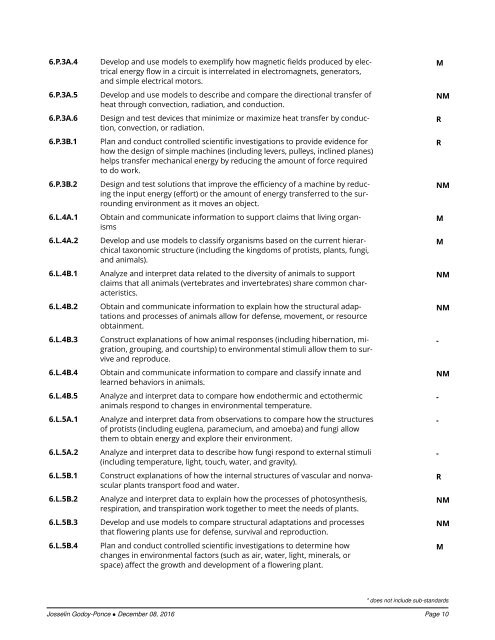josselin-godoy-ponce-progress-report
You also want an ePaper? Increase the reach of your titles
YUMPU automatically turns print PDFs into web optimized ePapers that Google loves.
6.P.3A.4<br />
6.P.3A.5<br />
6.P.3A.6<br />
6.P.3B.1<br />
6.P.3B.2<br />
6.L.4A.1<br />
6.L.4A.2<br />
6.L.4B.1<br />
6.L.4B.2<br />
6.L.4B.3<br />
6.L.4B.4<br />
6.L.4B.5<br />
6.L.5A.1<br />
6.L.5A.2<br />
6.L.5B.1<br />
6.L.5B.2<br />
6.L.5B.3<br />
6.L.5B.4<br />
Develop and use models to exemplify how magnetic fields produced by electrical<br />
energy flow in a circuit is interrelated in electromagnets, generators,<br />
and simple electrical motors.<br />
Develop and use models to describe and compare the directional transfer of<br />
heat through convection, radiation, and conduction.<br />
Design and test devices that minimize or maximize heat transfer by conduction,<br />
convection, or radiation.<br />
Plan and conduct controlled scientific investigations to provide evidence for<br />
how the design of simple machines (including levers, pulleys, inclined planes)<br />
helps transfer mechanical energy by reducing the amount of force required<br />
to do work.<br />
Design and test solutions that improve the efficiency of a machine by reducing<br />
the input energy (effort) or the amount of energy transferred to the surrounding<br />
environment as it moves an object.<br />
Obtain and communicate information to support claims that living organisms<br />
Develop and use models to classify organisms based on the current hierarchical<br />
taxonomic structure (including the kingdoms of protists, plants, fungi,<br />
and animals).<br />
Analyze and interpret data related to the diversity of animals to support<br />
claims that all animals (vertebrates and invertebrates) share common characteristics.<br />
Obtain and communicate information to explain how the structural adaptations<br />
and processes of animals allow for defense, movement, or resource<br />
obtainment.<br />
Construct explanations of how animal responses (including hibernation, migration,<br />
grouping, and courtship) to environmental stimuli allow them to survive<br />
and reproduce.<br />
Obtain and communicate information to compare and classify innate and<br />
learned behaviors in animals.<br />
Analyze and interpret data to compare how endothermic and ectothermic<br />
animals respond to changes in environmental temperature.<br />
Analyze and interpret data from observations to compare how the structures<br />
of protists (including euglena, paramecium, and amoeba) and fungi allow<br />
them to obtain energy and explore their environment.<br />
Analyze and interpret data to describe how fungi respond to external stimuli<br />
(including temperature, light, touch, water, and gravity).<br />
Construct explanations of how the internal structures of vascular and nonvascular<br />
plants transport food and water.<br />
Analyze and interpret data to explain how the processes of photosynthesis,<br />
respiration, and transpiration work together to meet the needs of plants.<br />
Develop and use models to compare structural adaptations and processes<br />
that flowering plants use for defense, survival and reproduction.<br />
Plan and conduct controlled scientific investigations to determine how<br />
changes in environmental factors (such as air, water, light, minerals, or<br />
space) affect the growth and development of a flowering plant.<br />
M<br />
NM<br />
R<br />
R<br />
NM<br />
M<br />
M<br />
NM<br />
NM<br />
-<br />
NM<br />
-<br />
-<br />
-<br />
R<br />
NM<br />
NM<br />
M<br />
* does not include sub-standards<br />
Josselin Godoy-Ponce • December 08, 2016 Page 10



